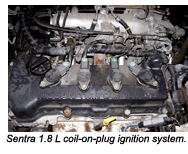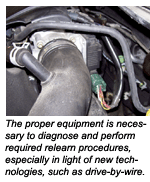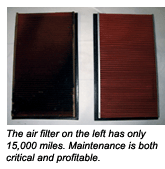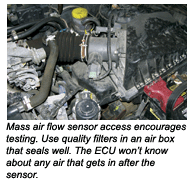As import specialist technicians and shop owners, we can be confident that there will be plenty of Nissans on the road for many years to come. Nissan continues to build cars and trucks that appeal to the American driver. Their customers have learned to expect many miles of solid service from these vehicles, and its our job to help them reach that goal by offering a quality, preventive maintenance plan and being prepared to handle any necessary diagnostic or mechanical repairs.
In this article, we’ll take a look at some of the common problems that affect engine performance. With on-board diagnostics (OBD), many of these problems will cause a check engine lamp (CEL) and store a code. With most of us becoming comfortable and proficient while working with OBD systems, we prefer having a code; it’s like having a hot tip to help pinpoint the problem. But that’s not always the case.
 We’ll start with some common electrical and ignition issues. In an effort to better control catalytic converter damaging misfires, Nissan has gone to coil-on-plug (COP) ignition systems, as have most other carmakers. There have been some problems with coil failures; the easy ones are the hard failures that result in a dead miss, with the code telling you which cylinder is the offender. If that’s the case, we simply confirm the failure by switching the coil with a running cylinder and confirm the miss moved with the coil. Don’t make the mistake of just replacing the offending coil by confirming the spark plug condition. It’s also a good time to suggest bringing maintenance up to date.
We’ll start with some common electrical and ignition issues. In an effort to better control catalytic converter damaging misfires, Nissan has gone to coil-on-plug (COP) ignition systems, as have most other carmakers. There have been some problems with coil failures; the easy ones are the hard failures that result in a dead miss, with the code telling you which cylinder is the offender. If that’s the case, we simply confirm the failure by switching the coil with a running cylinder and confirm the miss moved with the coil. Don’t make the mistake of just replacing the offending coil by confirming the spark plug condition. It’s also a good time to suggest bringing maintenance up to date.
Oftentimes, a P1320 primary ignition signal code is the first indication you’ll have of a coil failure. This code isn’t cylinder specific; the ECU is simply reporting that it didn’t see the expected signal from the ignition system. Experience tells us it’s a precursor to a coil failure.
There are a couple of strategies you can follow at this point. Using an ohmmeter, you can check the coils according to your service information. Or, you can take a look at the coils with your scope, or graphing meter using a low-amp probe, if your shop’s so equipped. The problem with this approach is that the failure is intermittent and it will be difficult to pick up the glitch.
Keep in mind this problem is subtle. I’ve never had a customer report a driveability problem associated with it. There were some problems with the coils when Nissan first went to the COP system, leading Nissan to recommend replacement of all the coils. I’ve never gone that route; it’s an expensive way to solve the problem and I just don’t feel right replacing parts that are good. Add in the fact that there’s been no pattern of the same car returning with multiple failures, I’ve never experienced the need to replace all the coils.
If no symptoms are present or reported, we recommend clearing the primary ignition code and suggest to the owner that he drives the car until a misfire code lets us know which cylinder is the problem. It’s not a high-tech approach, but most customers understand and appreciate the lower cost in taking this route.
On the other side of the ignition system, there was a manufacturing problem with crank and cam sensors that resulted in a recall about five years ago. If you’re faced with a car that has intermittent no-start or mysterious cutting-out problems, suspect a sensor failure. A code may or may not be set. And the problem is likely to be so difficult to duplicate that you have little choice but to make a diagnosis based on what you know, rather than on what you can confirm.
 Otherwise, cam and crank sensor problems are rare but not unheard of. There is one sensor-related problem that can be a real challenge on V6-powered cars. If you’re faced with an engine that sounds like it’s out of time when starting, but runs well once it starts, check the battery ground wire routing to see if it’s passing over the crank sensor. If so, simply rerouting the ground away from the sensor will straighten it out. We do this on all cars that get a new starter. We relocate the ground to one of starter mounting bolts from the original bracket. It’s necessary to enlarge the eyelet on the cable a bit, a task that’s easily taken care of with a tapered ream.
Otherwise, cam and crank sensor problems are rare but not unheard of. There is one sensor-related problem that can be a real challenge on V6-powered cars. If you’re faced with an engine that sounds like it’s out of time when starting, but runs well once it starts, check the battery ground wire routing to see if it’s passing over the crank sensor. If so, simply rerouting the ground away from the sensor will straighten it out. We do this on all cars that get a new starter. We relocate the ground to one of starter mounting bolts from the original bracket. It’s necessary to enlarge the eyelet on the cable a bit, a task that’s easily taken care of with a tapered ream.
Another starting issue that can be challenging and may have you looking at position sensors involves the electrical part of the ignition switch. Nissan, like many other carmakers, uses a bypass-type ignition switch that turns off power to accessories that aren’t required for startup when cranking. The problem comes when the terminal that should have power in the start position, doesn’t. The starter terminal still gets power, so you’re faced with a strong crank and no-start condition. Sometimes, customers report that it seems like the car starts when they let go of the key, but you can’t count on that. The best place to test for this is at the start fuse in the underdash fuse box. With the key in the start position, this fuse should show battery power. If not, it’s a safe bet that the ignition switch is the culprit.
Another problem that gets diagnosed as an engine-performance issue on these cars, and has probably caused more wasted time than any other issue, is when the key loses its memory and the immobilizer does its job of preventing the engine from starting. We’ve received lots of calls from shops that were fighting this one. The tip-off is that the injectors won’t get a ground signal from the ECU. Actually the best tip-off is the security light flashing on the dash as you try to start the car, but it’s easily overlooked. This problem usually requires having the car towed back to the dealer for a reprogram, or calling in a well-equipped locksmith, if you’re lucky enough to have one in the area.
On the earlier V6 cars, where the crank sensor is mounted on the front of the engine, there are some harness problems involving a bad connection on the right side near the strut tower. A good visual inspection is all you’ll need to find this problem. Be sure the harness is routed out of harms way when you’re done.
We’ve seen some problems with reference sensors on the older cars, where the sensors are located in the distributor housings. These cars use optical sensors whereby the light passes through small windows to keep the ECU abreast of engine speed and piston location. Any debris blocking the windows will cause anything from misfires to hesitations to no-run conditions. When faced with any of these situations, it takes only a couple of minutes to remove the cap, rotor and protective cover to check for debris. Be careful; these components are fragile and not readily available (although good quality rebuilds are available if needed or if there is any other problem that requires their replacement).
If you have the cap off, don’t forget to take a good look at the cap and rotors. If you’re in doubt as to their condition, replace them with quality OEM parts. We’ve had a couple of no-starts and hesitation complaints that were caused by bad rotors or cracked caps that would leak spark when wet. It’s a good idea to recommend a cap and rotor replacement with a 90,000-mile service; it’s an easy sell for most customers. Again, be sure to use quality OEM parts; cutting corners here will hurt you.
 CHECK ENGINE LIGHT NOT SET
CHECK ENGINE LIGHT NOT SET
Let’s take a look at some driveability problem areas that may not set a CEL, or may give you little more than a system lean or random misfire code. If you have a code, your first step is to go to the freeze-frame data. The information there will provide you with valuable clues to help you diagnose the problem.
If the CEL isn’t lit, it still pays to hook up the scanner to check for any stored or pending codes. Don’t forget to look at the data display; it takes only a couple of minutes to look for something that’s out of range. Don’t forget the fuel trim numbers. Is the ECU adding fuel at idle? Does the freeze-frame date show +20% fuel being added, and at what RPM, vehicle speed and temp.? There is a lot of good information available so there’s no reason not to use it. If you have enhanced Nissan software for your scanner, always be sure to check the generic or global OBD side to be sure you’re getting all the information available as well as the freeze-frame data.
ROUGH-RUNNING ALTIMA
So we have this Altima in the bay that’s running a little rough at idle; both you and the customer can feel it. The only hints we have are system lean and random misfire codes. The scanner is telling us that more fuel is being added at idle than we’d expect, and the O2 sensor is working but is biased lean. Your first thought might be to lift the coils in an attempt to pinpoint the offending cylinder, but you’ll notice little change as the ECU adjusts the idle speed and mixture to compensate for your actions.
Depending on your software, there may be a cylinder balance test available to you in the test function that would allow you to monitor the idle and fuel control as injectors are disabled; no doubt a better way to perform the test. Not only is it faster and actually helps you find the offending cylinder, it also gives you an indication of injector condition. The last advantage is that by turning off the injector, you’re not sending unburnt fuel into the cat or spiking the ignition coil.
If you’re doing enough import work that you’re reading this magazine, you should consider making the investment in enhanced software and learning to use it. We’ve pretty much reached the point that you can’t afford not to have all the diagnostic power that’s available. Not to mention the work support that’s provided with relearning procedures and bi-directional tests. On the Altima, a better strategy would involve going back to the basics. Start by hooking up the vacuum gauge. Do you have a fairly steady reading of 20-21 inches? If the needle isn’t steady, it’s time to confirm engine condition — steady and low, and you’re thinking air leak or timing. If you need a refresher on reading a vacuum gauge, a quick search on the Internet is all it takes. On this car, there was no indication of a timing problem. That leaves us looking for an air leak. The rough idle is an indication the leak is affecting certain cylinders more than others. The first thing to check is the intake gasket. More common on the four cylinders, it’s not difficult to confirm. Most can be picked up with a stethoscope and confirmed with a quick spray of intake cleaner to the gasket area. Look for the idle to smooth out and vacuum to increase.
We haven’t seen as many gasket problems on the V6s as we have on the four cylinders. There have been some reports of injector problems on the V6s, but mostly with the older cars. Any car can suffer from bad fuel, but I have to say we don’t see many and the ones we do usually show more symptoms.
 The other side of the system lean code may be accompanied by a complaint of low power, poor acceleration and hesitation. In this case, the idle is smooth with good trim numbers hovering around zero. Your freeze-frame info will get you heading in the right direction, telling you that the ECU noticed the same things your customer did, but will do a much better job of telling you when it happened.
The other side of the system lean code may be accompanied by a complaint of low power, poor acceleration and hesitation. In this case, the idle is smooth with good trim numbers hovering around zero. Your freeze-frame info will get you heading in the right direction, telling you that the ECU noticed the same things your customer did, but will do a much better job of telling you when it happened.
I’ve heard this code referred to as the oxygen sensor code. While a bad oxygen sensor can certainly cause this code, I’d be careful not to jump to conclusions. We know the trim numbers are good at idle so we have to think the oxygen sensors are doing what we expect there. They also were able to report the lean condition, so it’s safe to assume the engine is going lean at speed. We just have to find out why.
There are only two reasons for an engine to go lean — not enough fuel or too much air. We have to keep in mind that too much air could be unmetered air, not necessarily a vacuum leak. This leads us to look at the most influential sensors on the system. Nissans have been using hot wire-type MAF sensors for years, and thinking about the environment they live in, it’s not surprising they’ll have some problems. While there have been some electrical failures, the most common issue is a contaminated wire that won’t report the proper volume of air to the ECU. Without that information, it doesn’t know to add fuel.
With the scanner still hooked up, go to data and limit your parameters in the display to calculated load and short-term trim, then road-test the car, making note of your readings during full-throttle acceleration. Load should be at least 85%; trim will change as it sees acceleration enrichment but should level off and not go lean. A more detailed look can be taken with a graphing meter or scope. Back-probe the signal wire at the sensor, looking for a smooth increase of voltage as the throttle is opened. There should be no dropouts or glitches, with the voltage responding to any change in throttle opening. Snap throttle acceleration should result in a smooth climb to a maximum output of about 4 volts.
Some techs have good results with cleaning sensors, but I can’t say I share that experience. We will attempt to clean a visibly dirty one to confirm the diagnosis, but always recommend a replacement. To ensure a long-lasting repair, take a good look at the air intake system, being sure only air that goes through a quality filter is being ingested. Now is the time to replace any cracked housings or broken hoses that have been overlooked in the past.
We haven’t talked much about fuel pressure and, as I said, lean problems and poor performance could be the result, but Nissan doesn’t have much of a history with low fuel pressure issues. That’s not to say there haven’t been any problems with fuel pumps; it’s just that most of them will result in no-run problems rather than poor performance. One of the most common problems is actually the connection on the pump bracket where the wires go through the tank. Keep this in mind when replacing only the pump; better yet, use an OEM assembly and replace it with the pump.
I also want to mention the very common knock sensor code. This code doesn’t affect emissions and won’t illuminate the CEL. Mounted under the intake, it’s a labor-intensive job that has no apparent effect on driveability. If you’re diagnosing a driveability complaint and there’s no code other than the knock sensor, I suggest you check the things we’ve talked about. Take advantage of your tools, get all information the vehicle will give you and don’t forget the basics — fuel delivery, engine condition and condition of maintenance items all have to be considered to make a good diagnosis.
I hope this article helps you with your diagnostic challenges on Nissans and other vehicles, and will motivate you to take full advantage of the tools we have available. I have to remind you that the most powerful tools available today aren’t in your toolbox; it’s the repair information available on the Internet.
For example, log onto iATN, import-car.com (ImportCar magazine’s website) and nissantech.com (Nissan’s OEM service information website). If you’re not taking advantage of these resources, you’re not working smart.













